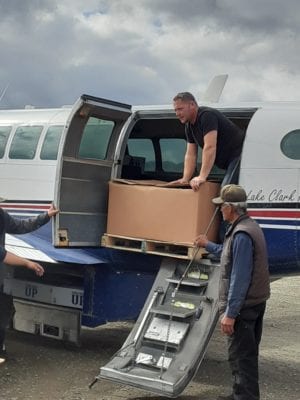
Tribal members from five Alaska Peninsula villages who gave up subsistence fishing this year after record-low salmon returns will fill their freezers with Bristol Bay sockeyes, a gift from two Southeast Alaska fishing entities.
The distribution of 45,000 pounds of Bristol Bay sockeye salmon began on Friday, Aug. 28, with subsistence harvesters from the Chignik area armed with coolers and large plastic sacks coming to a distribution point near Ted Stevens International Airport in Anchorage to get dozens of the whole frozen fish.
“Are you here to get fish?” said Ronald Lind, greeting folks as he began unloading some 1,300 pounds of sockeyes from a very large container on the back of his pickup truck. Lind, a former Chignik area harvester who now fishes Bristol Bay, volunteered to distribute the fish to everyone who had called in advance. The distribution was open to everyone who normally would have participated in the subsistence fishery.
Lind said he expected two more such distributions in Anchorage in the next couple of weeks.
Jennie Grunert, who is coordinating the overall distribution for the Chignik Lagoon Village Council, said more fish was being delivered directly to the five villages along the Alaska Peninsula.
“Each community down here I am asking how much fish they need,” she said. “Chignik Bay has received about 4,000 pounds, Chignik Lake got 2,500 pounds, Chignik Lagoon will get about 2,600 pounds, Perryville will get 7,500 pounds and Ivanoff Bay is getting all theirs in Anchorage, about 4,000 pounds.”
“It’s been fun to fill people’s freezers,” she said. “This has been incredibly generous.”
The idea came from Alaskans Own and Northline Seafoods, a project made possible by Catch Together, itself a project of the Trust for Conservation Innovation.
“The idea behind it is to foster connections throughout Alaska’s fishing communities by keeping the fisheries we depend on healthy and building new and more resilient distribution pathways for Alaska seafood,” said Linda Behnken, founder and director of Alaskans Own, the state’s first community supported fishery. Behnken, a commercial halibut and black cod harvester, is also the executive director of the Alaska Longline Fishermen’s Association in Sitka.
“Northline Seafoods purchases and processes our salmon in Bristol Bay,” said Ben Blakey, founder and president of the processing company. “Very few sockeye salmon returned to Chignik this summer, so when we got a call requesting some of our Bristol Bay sockeye, I said we could help.”
“It couldn’t have happened without a huge team effort,” Grunert said.
Grunert, a registered dietician, is the wife of a commercial fisherman with ties to the Chignik area. While they live in Anchorage, they come down to the Alaska Peninsula every year, where she is the director of the local food bank.
“It was a real team effort, she said. “Lake Clark Air helped with deliveries to Chignik Bay and more fish were to go to Chignik Lake and Perryville this coming week. Everyone is so excited about this project.”
The call for help came initially from George Anderson, president of the Chignik Intertribal council, Blakey said.
“They were looking for sockeyes to supplement their subsistence needs,” he said. “He didn’t have any financing to purchase. He asked if there was any way to make it happen.”
“It’s the best possible use of fish I could ever imagine,” Blakey said. “If we are in a place with bountiful harvest, we absolutely want to share it.”





